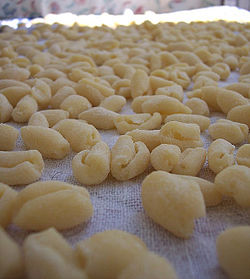Cavatelli
 Uncooked cavatelli | |
| Type | Pasta |
|---|---|
| Place of origin | Italy |
| |

Dry capunti, a variety of cavatelli from Apulia
Cavatelli [kavaˈtɛlli] are small pasta shells from eggless semolina dough that look like miniature hot dog buns.[1]Cavatelli in a literal sense, means "little hollows".[a] Ricotta cavatelli adds ricotta cheese to the dough mix.[1] It is commonly cooked with garlic and broccoli or broccoli rabe.

A dish of cavatelli
Contents
1 Regional names and varieties
2 See also
3 Notes
4 References
Regional names and varieties
Many varieties and local names of Cavatelli exist, including orecchie di prete (priest's ears).[2] In Apulia a number of varieties of Cavatelli have specific names including pizzicarieddi.[2]
A particular variety of Cavatelli is typical of the area of Teggiano in Campania, where they are referred to as Parmatieddi (or Palmatielli). Parmatieddi are larger than Cavatelli and flat-shaped. They are obtained by rolling a stick dough with three fingers of one hand, instead of with a single finger as done for the common Cavatelli. Parmatieddi are usually served as first course on Palm Sunday and their shape similar to that of a tree leaf, would like to recall that of palm branches the crowd scattered in front of Jesus when he entered into Jerusalem.[2]
See also
- List of pasta
Notes
^ Cognate to English cave and cavity.
References
^ ab "Pasta Shapes". Cook's Thesaurus. Retrieved 29 July 2011..mw-parser-output cite.citation{font-style:inherit}.mw-parser-output q{quotes:"""""""'""'"}.mw-parser-output code.cs1-code{color:inherit;background:inherit;border:inherit;padding:inherit}.mw-parser-output .cs1-lock-free a{background:url("//upload.wikimedia.org/wikipedia/commons/thumb/6/65/Lock-green.svg/9px-Lock-green.svg.png")no-repeat;background-position:right .1em center}.mw-parser-output .cs1-lock-limited a,.mw-parser-output .cs1-lock-registration a{background:url("//upload.wikimedia.org/wikipedia/commons/thumb/d/d6/Lock-gray-alt-2.svg/9px-Lock-gray-alt-2.svg.png")no-repeat;background-position:right .1em center}.mw-parser-output .cs1-lock-subscription a{background:url("//upload.wikimedia.org/wikipedia/commons/thumb/a/aa/Lock-red-alt-2.svg/9px-Lock-red-alt-2.svg.png")no-repeat;background-position:right .1em center}.mw-parser-output .cs1-subscription,.mw-parser-output .cs1-registration{color:#555}.mw-parser-output .cs1-subscription span,.mw-parser-output .cs1-registration span{border-bottom:1px dotted;cursor:help}.mw-parser-output .cs1-hidden-error{display:none;font-size:100%}.mw-parser-output .cs1-visible-error{font-size:100%}.mw-parser-output .cs1-subscription,.mw-parser-output .cs1-registration,.mw-parser-output .cs1-format{font-size:95%}.mw-parser-output .cs1-kern-left,.mw-parser-output .cs1-kern-wl-left{padding-left:0.2em}.mw-parser-output .cs1-kern-right,.mw-parser-output .cs1-kern-wl-right{padding-right:0.2em}
^ abc De Vita, Oretta Zanini (2009). Encyclopedia of Pasta. Berkeley: University of California Press. pp. 73, 195.
This Italian cuisine–related article is a stub. You can help Wikipedia by expanding it. |
